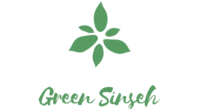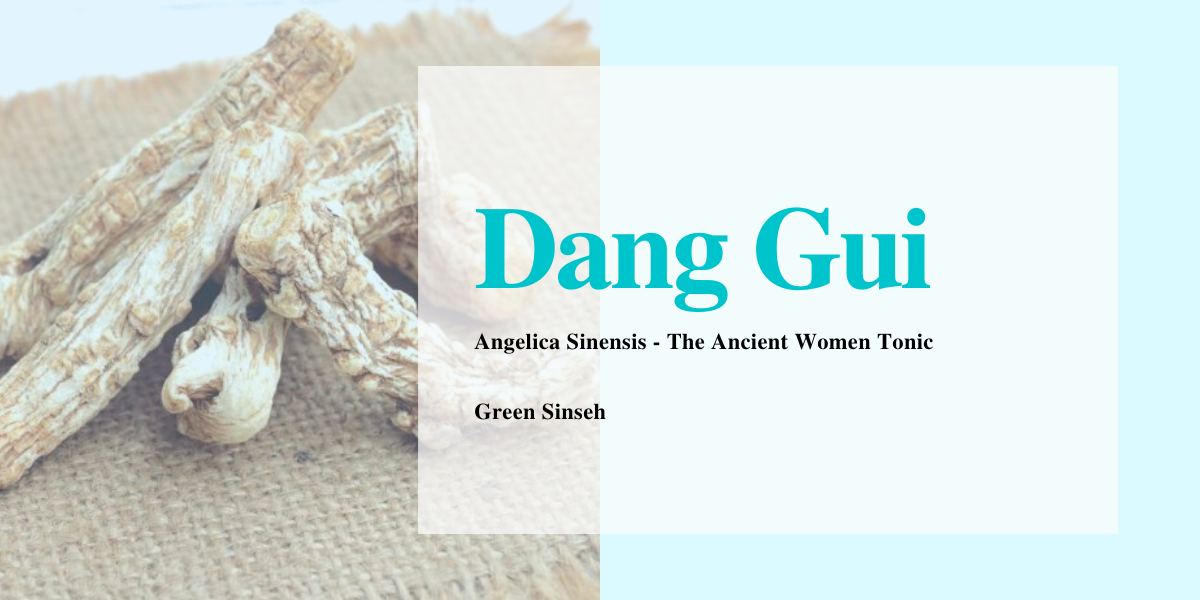Dang Gui in Plant-based Diet
Radix Angelica Sinensis, the dried root of Angelica sinensis (Danggui), is a herb used in Chinese medicine to enrich blood, promote blood circulation and treat blood deficiency pattern and menstrual disorders such as dysmenorrhea and irregular menstrual cycle [1]. Dang gui is usually used in plant-based diet herbal soups as it can help to treat iron-deficiency anemia. It is also used to treat chronic constipation of the elderly. Research has demonstrated that Danggui and its active ingredients(namely Ferulic acid and Courmarin), as anti-arthrosclerotic, anti-hypertensive, antioxidant anti-inflammatory agents which would limit platelet aggregation, are effective in reducing the size of cerebral infarction and improving neurological deficit scores.
Latin Name: Radix Angelicae Sinensis
Common Name: Angelica root
Scientific Name: Angelica sinensis (Oliv.) Diels
Chinese Name: 當歸 (当归)
Pinyin Name: dang gui
The body of Dang Gui is typically known simply as Dang Gui(当归) or the name can change depending on the way its cut. For example a flat cross cut can be sold as Dang Gui Pian(当归片), but this is still simply the body of the herb. The other more common way to buy Dang Gui is buying just the tails of the root called Dang Gui Wei(当归尾).
Dang Gui has 2 main functions: Tonify Blood and Move (invigorate) Blood(补血活血). The higher up the herb you go, called the head, the more of a blood tonic it is. The bottom or tail has more of a movement of blood quality the further down you go.
Dang Gui Herbal Uses-
Build blood, regulate menses, and nourish skin and body.
Dang Gui Wei Herbal Uses-
Used to move blood for stasis of blood while nourishing.
Herbal Properties-
The entire root is warming, moving and very tonifying.
Pharmacological Functions of Dang Gui
- hematopoietic effect,
- cardiovascular effects (protection of the cardiovascular system against ischemia, relaxation of blood vessels and vascular protection effect in endothelial cells, anti-oxidation, anti-platelet aggregation, and regulation of hemorrheology),
- effects on gynecological imbalances (dysmenorrhea alleviation, estrogenic activity, andanxiolytic effects),
- neuro-protective activity,
- wound healing,
- anti-cancer effects. [2]
More than 50 active components have been isolated from angelica root. These active compounds include polysaccharides, organic acids, and phthalates. Ferulic acid and Z-ligustilide are major bioactive components of angelica root.
Dang Gui is also rich in phytoestrogens, botanical substances that mimic the action of estrogen. It has the ability to balance female hormone levels and can be used during the menstrual cycle as well as during menopause and perimenopause. It is useful for treating hot flashes, mood swings, headaches and other menopausal symptoms. Additionally, because of its ability to improve circulation it is good to use when recovering from illness or injury.
This is particularly important in those on vegan diet who avoid honey as honey can be a natural alternative to estrogn-replacement therapy. Royal jelly to be exact. However, dang gui can do just as fine, just that amount may vary in individuals.
Also, recent studies are proving its benefits in cancer patients receiving chemotherapy (such as doxorubicin and bleomycin) and radiation treatments for its ability to counteract oxidative damage caused by both treatment methods (Zhou et al., 2007; Guang et al., 2006).
How TCM uses Dang Gui
In Traditional Chinese medicine, angelica roots is used for tonifying, replenishing, and invigorating blood as well as relieving pain, lubricating the intestine, and treating female irregular menstruation and amenorrhea.
Angelica root is sweet, pungent and slightly bitter in flavors, warm in nature and manifests its therapeutic actions in the liver, heart and spleen meridians.
In my country Singapore, our medical system is primarily Western Medicine. Suffers of irregular menstruation are usually prescribed with birth control pills to ‘regulate’ their periods. In my article, How I Treat PCOS, I discussed about how TCM can regulate periods without any birth control pills and how it is done.
Women have the job of building up and getting rid of blood monthly. Sometimes this is too much a loss of blood, the flow is not ‘fluid’ and has stasis, and sometimes there is a problem building up this blood. Any of these problems lead to pain, irregular menses, cramps, and abdominal pain. Dang gui by itself builds blood and moves blood(补血活血). These are basically the 2 fundamental problems of irregular menses and this 1 herb covers both.
Dang Gui is also a moistening herb. Internally this helps moisten the intestines for your stool. Externally this helps with moistening and generating flesh in the case of burns, sores, and rashes.
When is Danggui used
Anyone with blood deficiency. Other dang gui, you can visit my other post where I go deeper into iron deficiency and TCM diet.
Blood deficiency is characterised with
- sallow face,
- paleness,
- dizziness,
- blurred vision, and
- palpitation。
Angelica root is also an important herb for regulating menstruation. It often combines with herbs like rhemannia rhizome, peony root and Sichuan lovage rhizome to treat problems like irregular periods, menstrual pain, missed periods and postpartum abdominal pain.
Contraindications of Dang Gui
- Breast cancer sufferers should not take Danggui since its estrogen components could significantly promoting the proliferation of breast cancer cells.
- Danggui should also not be used in combination with anticoagulants because their synergistic effect could increase the risk of hemorrhage. It’s strongly suggested to use Danggui under your doctor’s professional advice.
- It is contraindicated in cases of damp-heat stagnating in the middle, lung heat with phlegm fire, and yin deficiency with effulgent yang because it is warm and sweet in properties. In addition, it should be used with cautions in cases of loose stool because it can moisten intestines to smooth stool.
Plant-based Danggui Recipes
1. Energising Tonic (十全大补汤)
The Chinese name Shi Quan Da Bu Tang literally means “all-inclusive great tonifying decoction” or “ten complete tonic decoction.” This classical formula powerfully tonifies Qi and blood and also warms the Yang. It is traditionally used for lack of energy, shortness of breath, lightheadedness, pale face, low appetite, intolerance to cold, spontaneous perspiration, or weakness of the lower extremities.
Herbal Ingredients
| Radix Codonopsis Pilosulae Rhizoma Atractylodis Macrocephalae Sclerotium Poriae Cocos Radix Glycyrrhizae Uralensis Radix Angelicae Sinensis Rhizoma Ligustici Chuanxiong Radix Paeoniae Lactiflorae Radix Rehmanniae Preparata Radix Astragali Membranacei Cortex Cinnamomi Cassiae | (Dang Shen) 党参 10g (Bai Zhu) 白术10g (Fu Ling) 茯苓10g (Gan Cao) 甘草5g (Dang Gui) 当归8g (Chuan Xiong) 川芎5g (Bai Shao) 白芍10g (Shu Di Huang) 熟地黄10g (Huang Qi) 黄芪 10g (Rou Gui) 肉桂 6g |
Other ingredients
| Ginger, sliced Black sesame oil Corn Monkey head mushrooms Shitake mushrooms Napa cabbage Other items can include tofu, mock meat. | 20-25 slices 3-5 tbps 1, cut into smaller pieces 6 pieces, cut 6 pieces, cut 100-300g Up to individual |
Instructions
- Wash the herbs and put all into a soup bag to prevent the herbs from scattering around during cooking.
- Saute ginger with black sesame oil till fragrant, and add in mushrooms and saute for 3-5 minutes.
- Add them into a 2 litre boiling water with the herbs, and cook under small flame for 2-3 hours.
- Add the cabbage for 3-5minutes
- Add salt to taste and serve.
- Chronic atrophic gastritis: Modified Shi Quan Da Bu Tang was used to treat 54 patients of chronic atrophic gastritis with good success. The herbs were administered in decoction twice daily in the morning and at night. The treatment period was six months for one course of treatment. The overall effectiveness rate was 98.15 percent.[3]
- Gastric prolapse: Concurrent treatment using acupuncture and herbs was found to be very effective in the treatment of gastric prolapse characterized by deficiencies of qi and blood with zhong (central) qi collapse. The treatment protocol for herbs was to administer Shi Quan Da Bu Tang for a total of 70 doses. Out of 15 patients, the study reported complete recovery in four patients, improvement in 10, and no benefit for one. [4]
- Post-surgical recovery: Administration of Shi Quan Da Bu Tang has marked beneficial effects on gastric cancer patients during the postoperative recovery by improving interleukin-2 reactivity, natural killer (NK) activity, nutritional index and bone mineral indices. [5]
- Cancer: According to one report that screened and evaluated 116 herbal formulas for treatment of cancer, Shi Quan Da Bu Tang was determined to be the most effective. Clinical benefits of Shi Quan Da Bu Tang included extremely low toxicity, self-regulatory and synergistic actions of its components in immuno-modulatory and immuno-potentiating effects, enhanced therapeutic activity in chemotherapy and radiotherapy, inhibited recurrence of malignancies, prolonged survival and reduced adverse toxicities of many anticancer drugs. [6]
- Anemia: Administration of Shi Quan Da Bu Tang effectively increased hemoglobin, red blood cells and platelets in 41 patients with post-surgical proteinemia. [7]
2. Dang Gui Huang Qi Tea
| Dang gui 当归 Huang qi 黄芪 Red Dates 红枣 | 15g 30g 15g |
Instructions:
- Wash the herbs and put into a tea bag
- Cook the herbs with 500-800ml to boil
- Turn to small flame and continue to cook for 20 minutes.
- Serve
Conclusion
In my clinical practice, I have many patienrs who are on plant-based diets yet low on haemoglobin. Fatigue, low energy levels, pale complexion are their usual complaints. This has further spurred me on to find out how can TCM help them on a molecular level as well as on a macro perspective. Therefore I wrote this article dedicated to one of the most well-known TCM herb that is used to increase blood count and boost circulation.
If you are facing any other issues that need further investigation, don’t hesitate to book an appointment with me.
About Me
Edmund graduated with a First Class Hons in Biomedical Sciences and Traditional Chinese Medicine from Nanyang Technological University, before taking a Masters in Gynaecology(TCM) in Liaoning, China.
He has successfully treated patients with unexplained infertility, Polycystic Ovarian Syndrome(PCOS) and endometriosis and helped them conceive naturally with Traditional Chinese Medicine.
References
1. Hou TC. Herbal Extracts. 1. Vol. 1. Beijing: China Medical Scientific Technological Publishing Company; 2004. pp. 173–183. In Chinese. [Google Scholar] [Ref list]
2. Jin et al (2012) Isolation, structure and bioactivities of the polysaccharides from Angelica sinensis (Oliv.) Diels: a review. Carbohydr Polym 89(3):713–722
3. He Bei Zhong Yi (Hebei Chinese Medicine) 1987;6:16.
4. Fu Jian Zhong Yi Yao (Fujian Chinese Medicine and Herbology) 1985;3:19.
5. Horie Y, Kato K, Kameoka S, Hamano K. Bu ji (hozai) for treatment of postoperative gastric cancer patients. Am J Chin Med 1994;22(3-4):309-19.
6. Zee-Cheng RK. Shi-quan-da-bu-tang (Ten Significant Tonic Decoction), SQT. A potent Chinese biological response modifier in cancer immunotherapy, potentiation and detoxification of anticancer drugs. Methods Find Exp Clin Pharmacol 1992 Nov;14(9):725-36
7. Zhong Xi Yi Jie He Za Zhi (Journal of Integrated Chinese and Western Medicine) 1989;10:622.

